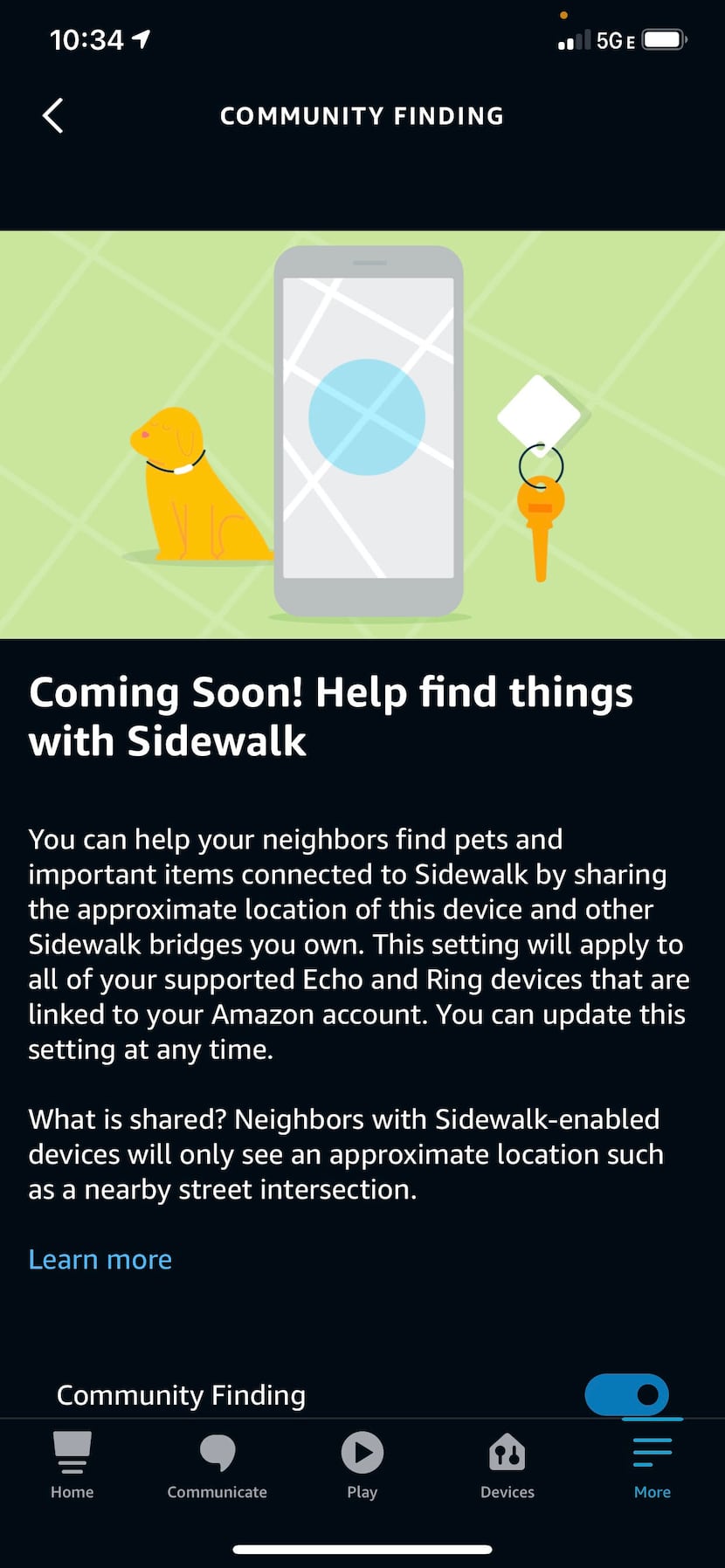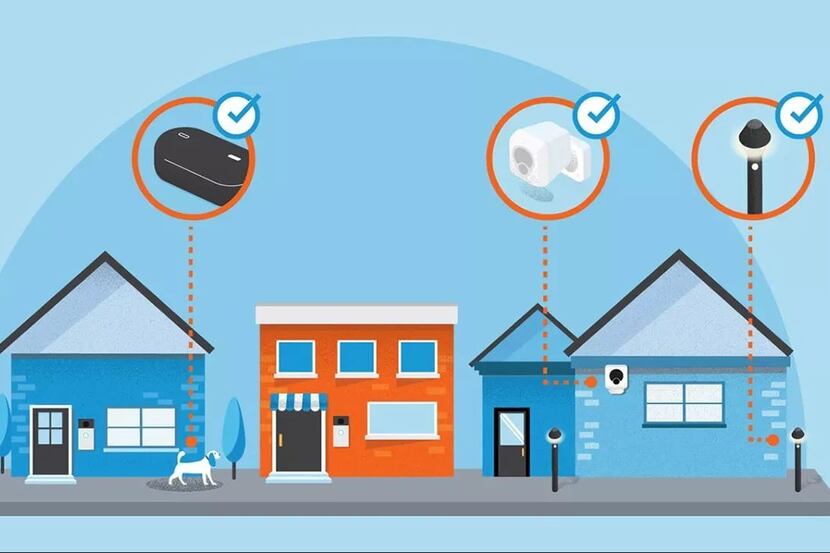If you own an Amazon Echo Alexa voice assistant or Ring doorbell or camera, I’m hoping you’ve at least heard of a new technology from Amazon called Sidewalk, which is drawing a bit of controversy.
Amazon Sidewalk shares a small portion of your internet service with Amazon devices and third-party gadgets that partner with Amazon in areas outside your home.
Sidewalk is a hidden network, meaning you won’t be able to walk over to your neighbor’s house and log into the Sidewalk network and start using their Wi-Fi. The data transmissions of Sidewalk are limited to low-bandwidth connections. The devices that can use Sidewalk will automatically do so if they find a network connection.
Let’s say you and your neighbors on either side all have Echo or Ring devices and have Sidewalk enabled.
If your internet goes down, your Echo or Ring devices can still operate using the Sidewalk network from a neighbor. This only works if there is someone with Sidewalk enabled and within range of your devices (close neighbors). The Sidewalk network should reach the street outside your house. The broadcast range is fluid, depending on how close the device (Sidewalk bridge) is to the outside walls of the house. I’d estimate that it would reach not more than 100 to 200 feet from your house.
Lost keys, lost pets
Right now, there are very few Sidewalk clients other than the Tile Bluetooth locator. Earlier this year, Tile and Amazon announced that Tile locators would be the first users of Sidewalk.
To me, the addition of Sidewalk to the Tile locator service is a big deal.
Right now, if I lose my keys (with my Tile Pro attached), I can go to the Tile app and put that Tile into “lost mode,” which tells the Tile server to start looking for my Tile.
If someone else with the Tile app running on their phone comes within Bluetooth range of my Tile, their app will notify the Tile server of the location and relay that information to me. This all happens without any interaction from the users.
With the addition of Amazon Sidewalk, Tile users no longer have to rely solely on other Tile users to help find their Tiles.
Instead, Tiles can check in with the server any time they come within range of a Sidewalk bridge device.
If I drop my keys on my nightly walk around the neighborhood, and one of the houses nearby has Sidewalk enabled, I will get a notification when I tell Tile that I’ve lost something.
If Sidewalk is used widely, I think a great use for Tiles would be to keep track of your pets.
If you put a tile on your dog’s collar, and your dog gets out of the yard, any home with Sidewalk enabled can relay the location of your dog back to your phone.
Of course, if nobody enables Sidewalk, it can’t help you.
Sidewalk has been on the horizon for a while now, and starting June 8, Amazon began turning on the feature in millions of Echoes and Ring devices. But it’s not asking your permission to do it.
Is this a good thing?
It’s too soon to tell, but ultimately you get to decide.
Am I going to let Amazon share some of my internet bandwidth?
Yes, I am. I’ll explain more below.
What is Sidewalk?
According to Amazon: “Sidewalk is a shared network that helps devices like Amazon Echo devices, Ring Security Cams, outdoor lights, motion sensors and Tile trackers work better at home and beyond the front door. When enabled, Sidewalk can unlock unique benefits for your device, support other Sidewalk devices in your community and even locate pets or lost items.”

Amazon’s Sidewalk website says: “Sidewalk creates a low-bandwidth network with the help of Sidewalk Bridge devices, including select Echo and Ring devices. These Bridge devices share a small portion of your internet bandwidth, which is pooled together to provide these services to you and your neighbors. And when more neighbors participate, the network becomes even stronger.”
There are two parts to the Sidewalk network — bridges and clients. The bridges share the internet, and the clients use that shared network.
The Amazon devices that are Sidewalk bridges include:
- Amazon Echo (3rd and 4th Gen)
- Amazon Echo Dot (3rd and 4th Gen)
- Amazon Echo Dot for Kids (3rd and 4th Gen)
- Amazon Echo Dot with Clock (3rd and 4th Gen)
- Amazon Echo Plus (1st and 2nd Gen)
- Amazon Echo Show (1st and 2nd Gen)
- Amazon Echo Show 5, 8 and 10
- Amazon Echo Spot
- Amazon Echo Studio
- Amazon Echo Input
- Amazon Echo Flex
Your Amazon Echo and Ring devices can also use Sidewalk as clients.
Amazon says Sidewalk uses multiple layers of encryption to secure data on the network. You won’t have access to any information about other people’s devices. It all happens behind the scenes.
According to Amazon, “Information transferred over Sidewalk Bridges is encrypted, and Bridge customers are not able to see that Sidewalk-enabled devices are connected to their Bridge. Customers who own Sidewalk-enabled devices will know they are connected to Sidewalk but will not be able to identify which Bridge they are connected to.”
So how does it work?
Sidewalk will broadcast a small portion of your internet as a hidden mesh network for its clients to use. The Sidewalk bridges use the 900 megahertz spectrum to relay your internet.
Amazon says it will share up a maximum of 500 kilobytes of your data per month, which is the equivalent of watching 10 minutes of HD video. It will also limit the speed to 80 kilobits per second, which you should not notice.

I can’t help but compare Sidewalk with Apple AirTags.
Apple is basically doing the same thing — sharing part of your cellphone’s data plan to help locate lost AirTags.
When I reviewed AirTags, I thought it was a great service and was all for it.
I’m also a Tile user, and I suppose I’d feel a little hypocritical if I didn’t feel similarly about Sidewalk.
How to opt out
If you feel uncomfortable about Amazon using a bit of your internet, you can turn it off in the Alexa app or Ring app.
For Amazon devices, open the Alexa app, touch More on the bottom row of icons, then choose Settings, then Account Settings and finally Amazon Sidewalk.

On the Sidewalk settings page, the only option is to disable Sidewalk, and it applies to all Amazon devices on your account.
Ring users should launch the Ring app, touch the three lines on the upper left corner of the screen, tap Control Center then tap Sidewalk and you’ll see the slider button. You’ll be asked to confirm that you want to disable Sidewalk.
You can turn it on in the same place.
Should you leave it on?
The fact that Amazon is choosing to enable Sidewalk by default is rubbing people the wrong way and making Amazon seem like Big Brother.
If Sidewalk is so great, Amazon should do a better job of explaining it to customers and let them turn it on if they choose.
I think I will enable it for now, but I’ll be monitoring any Sidewalk news and will re-evaluate pretty regularly.
I am a big user of Amazon for shopping, and we have two Echo Dots in our home to help with home automation voice control and other voice assistant things (Alexa, what’s the temperature?). We also use Echo Dots as our alarm in the morning.
Amazon knows a lot about us, and I don’t think Sidewalk is going to tell the company more than it knows already.
Whether you enable Sidewalk or not is up to you. I’m not about to tell you what to do on your network.
But I see the benefits of Sidewalk for now — if enough people opt in to make it viable.

